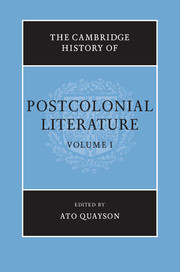Book contents
- Frontmatter
- 1 Introduction: postcolonial literature in a changing historical frame
- 2 Postcolonial fictions of slavery
- 3 Postcolonialism and travel writing
- 4 Missionary writing and postcolonialism
- 5 Postcolonial auto/biography
- 6 Orality and the genres of African postcolonial writing
- 7 Canadian literatures and the postcolonial
- 8 Postcolonialism and Caribbean literature
- 9 Postcolonialism and Arab literature
- 10 Postcolonialism and postcolonial writing in Latin America
- 11 Postcolonial writing in South Africa
- 12 Postcolonial literature in Southeast Asia
- 13 Postcolonial South Asian poetry
- 14 Postcolonial writing in India
- 15 Postcolonial writing in Australia and New Zealand
- 16 Indigenous writing in Canada, Australia and New Zealand
- 17 Postcolonial writing in Ireland
- 18 Postcolonial writing in Britain
- 19 Postcolonial writing in France
- 20 Postcolonial writing in Germany
- References
16 - Indigenous writing in Canada, Australia and New Zealand
Published online by Cambridge University Press: 28 January 2012
- Frontmatter
- 1 Introduction: postcolonial literature in a changing historical frame
- 2 Postcolonial fictions of slavery
- 3 Postcolonialism and travel writing
- 4 Missionary writing and postcolonialism
- 5 Postcolonial auto/biography
- 6 Orality and the genres of African postcolonial writing
- 7 Canadian literatures and the postcolonial
- 8 Postcolonialism and Caribbean literature
- 9 Postcolonialism and Arab literature
- 10 Postcolonialism and postcolonial writing in Latin America
- 11 Postcolonial writing in South Africa
- 12 Postcolonial literature in Southeast Asia
- 13 Postcolonial South Asian poetry
- 14 Postcolonial writing in India
- 15 Postcolonial writing in Australia and New Zealand
- 16 Indigenous writing in Canada, Australia and New Zealand
- 17 Postcolonial writing in Ireland
- 18 Postcolonial writing in Britain
- 19 Postcolonial writing in France
- 20 Postcolonial writing in Germany
- References
Summary
Words of power
‘Words are sacred’, Anishinaabe poet and editor Kateri Akiwenzie-Damm reminds us. ‘They can transform. Words can change peoples’ attitudes, their thinking, their construction of reality, their actions. Words can change the world. As can silence’. To understand the literatures of Indigenous peoples in Canada, one must recognize the power of words, especially when their source is rooted in the peoples who have called this land home for thousands of years, and whose voices have all too often been passively ignored or actively silenced since the onset of European invasion in the sixteenth century.
In the continuing colonial context of Canada, where Aboriginal peoples make up just over 3 per cent of the entire population, the very existence of Indigenous words is a reminder that this is, indeed, a colonized land, and that its first peoples have not gone away or resigned themselves to silence. If anything, their words – in writing as well as ceremony, song, and performance and visual art – affirm the growing representational strength of Native peoples in this land, a strength born of both expansive vision and continuing struggle. The resulting expressive archive – richly realized and diverse in form, purpose and content – constellates a very different understanding of Canada than that assumed by its settler citizens.
- Type
- Chapter
- Information
- The Cambridge History of Postcolonial Literature , pp. 484 - 538Publisher: Cambridge University PressPrint publication year: 2012
References
- 1
- Cited by



